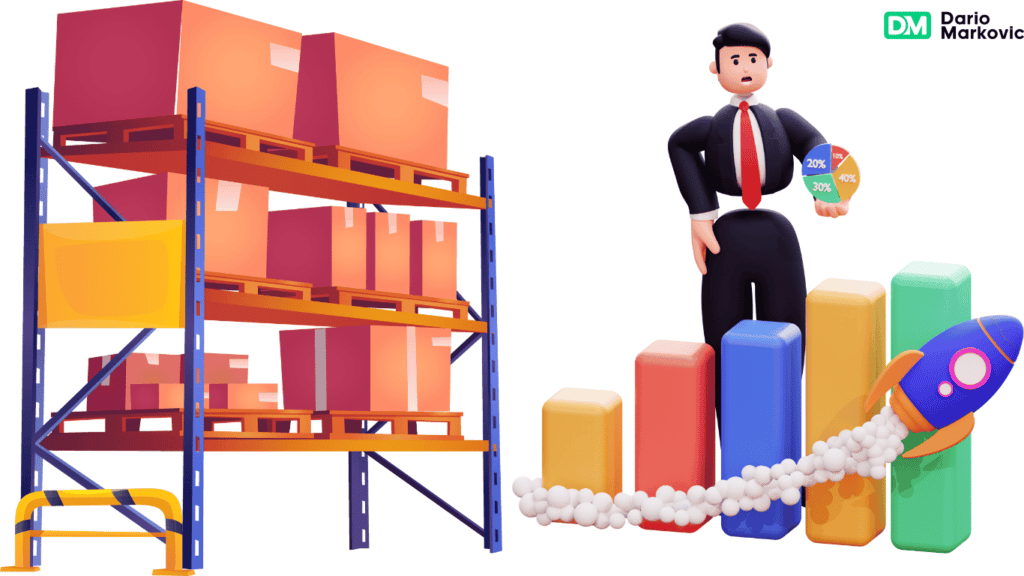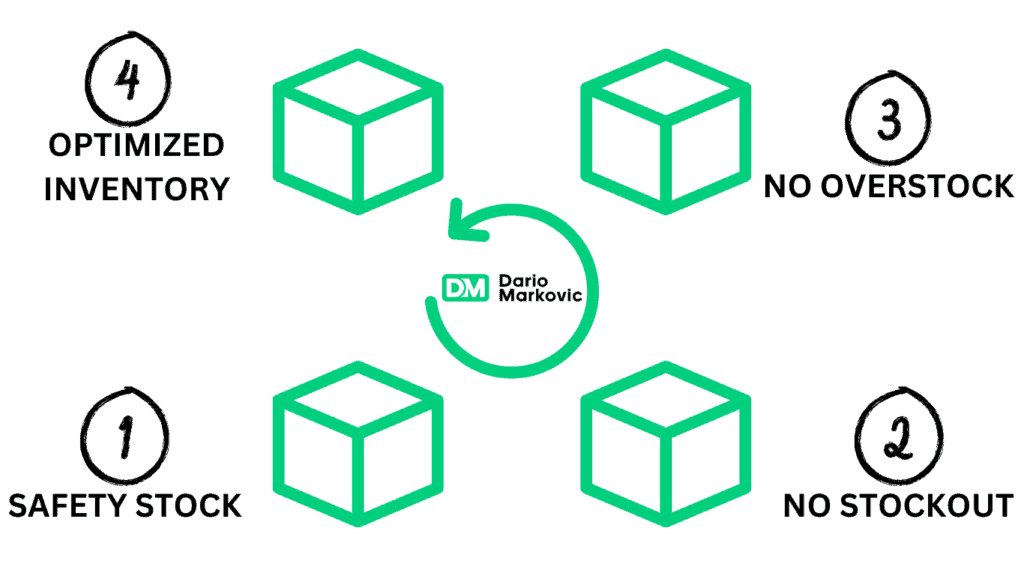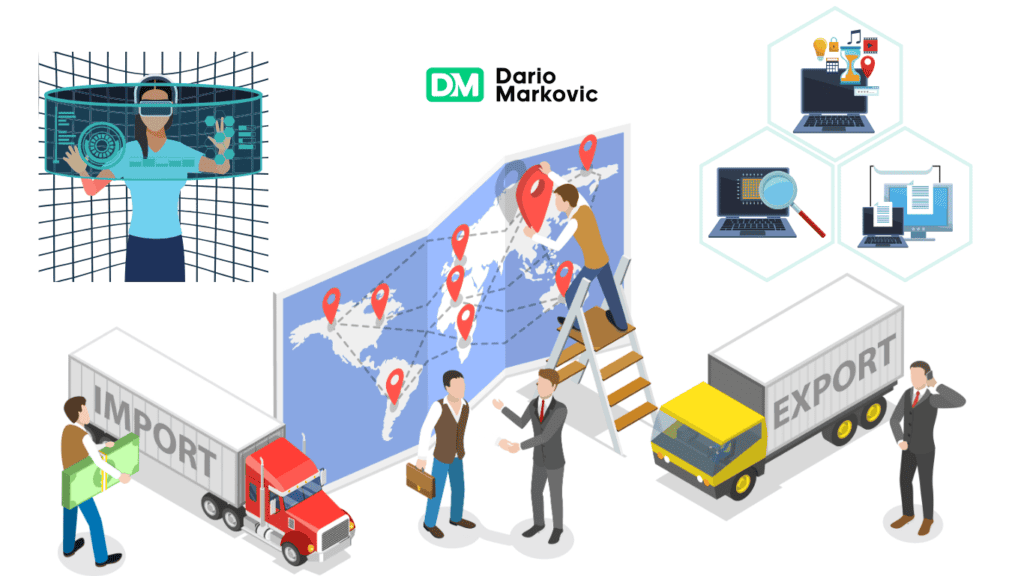I’ve got helpful information if you’re ready to take your supply chain organizations to new heights. With some know-how and smart inventory and supply chain management strategies, you can manage inventory levels and keep your supply chain going.
Dealing with everything from stockouts to overstocking is a great experience. And let me tell you, it’s not always pretty.
But through trial and error (and a lot of coffee), I’ve discovered some game-changing strategies I can’t wait to share with you.
Listen up, folks! Whether you’re running a small business or managing the supply chain for a large corporation, these inventory and supply chain management tips are guaranteed to make your life easier.
From streamlining processes to reducing waste, we’ll cover all the bases and help you become an optimization wizard. Let’s jump right in and start transforming your business.
Understanding Inventory and Supply Chain Management

Inventory management is the invisible thread that connects various supply chain elements. Its impact ripples across industries, influencing operational efficiency, customer satisfaction, and financial performance.
Importance of Inventory Management in Supply Chain
Effective supply chain inventory management is a strategic process that involves planning, implementing, and controlling the production and delivery of goods or services to the end customer.
It focuses on optimizing and coordinating the entirety of supply chain operations. Inventory management techniques help businesses meet customer demand, optimize costs, and mitigate risks.
It’s a critical component of supply chain management that involves overseeing and controlling the flow of goods from manufacturers to warehouses and from these facilities to point of sale.
Key Components of Supply Chain Management
Supply chain management encompasses several key components:
- Planning: Developing a comprehensive strategy, forecasting demand, setting inventory levels, and formulating production schedules ahead
- Sourcing: Identifying suppliers, negotiating contracts, and managing vendor relationships
- Production: Overseeing the manufacturing process, including scheduling, quality control, and operational optimization
- Inventory management: Supervise stock levels, forecast demand, and manage order quantities to balance customer needs without excess inventory. You can also opt to hire supply chain managers to supervise.
- Logistics and transportation: Monitoring the movement of products (with a focus on transportation, warehousing, and distribution) from suppliers to consumers
- Collaboration: Various moving parts across the supply chain mean inventory management requires a coordinated effort between suppliers, manufacturers, distributors, partners, and customers.
Benefits of Effective Inventory Management

Businesses that adapt to technological advancements and data analytics, respond to changing consumer demands, and implement efficient inventory and supply chain management strategies have paved the way for more effective inventory control practices.
Embracing these practices benefits businesses directly and contributes to a healthier and more resilient global supply chain ecosystem. Some key benefits include:
- Ensuring product availability
- Minimizing carrying costs
- Reducing stockouts and overstocking
- Facilitating supply chain coordination
- Optimizing costs
- Mitigating risks
Optimizing Inventory Levels for Efficiency

Determining optimal inventory levels is a delicate balancing act. You want enough stock of raw materials to meet customer demand but not so much that you’re tying up excess capital or risking obsolescence.
Determining Optimal Inventory Levels

Finding that sweet spot involves calculating factors like:
- Demand forecasts
- Lead times
- Safety stock requirements
- Inventory turnover rates
- Carrying costs
Techniques like economic order quantity (EOQ) and reorder point analysis can help businesses calculate the most cost-effective inventory levels based on these variables.
The goal is to balance having enough inventory to meet demand while minimizing holding costs.
Implementing Safety Stock Strategies

Safety stock is the extra inventory kept on hand to buffer against variability in supply and demand. Implementing safety stock strategies involves:
- Determining appropriate safety stock levels based on desired service levels
- Analyzing lead time variability
- Assessing demand fluctuations
Statistical models like normal distribution and Poisson distribution can be used to calculate optimal safety stock quantities.
The key is to have enough safety stock to prevent stockouts but not so much that it significantly increases carrying costs. Optimizing inventory levels and improving your inventory and supply chain management!
Balancing Inventory Costs and Customer Service

Optimizing inventory is a constant trade-off between cost and service. Too much inventory increases costs, while too little can lead to stockouts and lost sales.
Effective strategies to strike this balance include:
- Segmenting inventory based on demand patterns (e.g., ABC analysis)
- Implementing just-in-time inventory to reduce holding costs
- Using service level agreements to align inventory with customer expectations
- Regularly reviewing and adjusting optimal inventory levels
The goal is to find the right balance to minimize costs while meeting customer demand and service level expectations. It’s an ongoing process that requires regular monitoring and adjustment.
Implementing Inventory Management Systems

Inventory management systems are the backbone of effective inventory and supply chain management. They provide the visibility, control, and automation needed to optimize inventory levels and streamline fulfillment operations.
Types of Inventory Management Systems
There are several types of inventory management systems, each with its own strengths and use cases:
- Periodic review systems that count inventory at regular intervals
- Perpetual systems that continuously update inventory records
- Two-bin systems that use visual signals for reordering
- Barcode systems for automated data capture
- RFID systems for real-time tracking
More advanced systems integrate with enterprise resource planning (ERP) software for end-to-end supply chain visibility.
The right system and business plan depend on the industry, inventory complexity, and business size.
Benefits of Inventory Management Software
Inventory management software provides numerous benefits, such as:
- Real-time visibility into stock levels
- Automated reordering and replenishment
- Improved accuracy through barcode scanning and RFID
- Advanced analytics for inventory optimization
- Cloud-based access from anywhere
- Integration with other supply chain systems
Inventory management software automates manual processes and provides real-time data, enabling businesses to make more informed decisions.
This leads to reduced costs, improved efficiency, and better customer service.
Integrating Inventory Management with Warehouse Operations

One crucial key to inventory and supply chain management is integrating inventory management with warehouse operations, vital for efficient order fulfillment. This involves:
- Optimizing warehouse layouts and pick paths
- Implementing technologies like pick-to-light and voice-picking
- Using warehouse management systems (WMS) to orchestrate inventory movements
- Integrating with transportation management systems (TMS) for end-to-end visibility
By seamlessly integrating inventory management with warehouse operations, businesses can improve inventory accuracy, enable real-time order processing, and streamline the flow of finished goods.
This leads to faster fulfillment times, lower costs, and happier customers.
Forecasting Demand for Accurate Inventory Planning
Accurate demand forecasting is the foundation of effective inventory planning. It enables businesses to anticipate customer needs, optimize stock levels, and avoid costly stockouts or overstocking.
Techniques for Demand Forecasting
There are various techniques for demand forecasting, each with its own strengths and use cases:
- Time-series methods like moving averages and exponential smoothing
- Causal methods that consider factors influencing demand
- Qualitative methods that rely on expert judgment
- Machine learning algorithms that analyze historical data and predict future demand patterns
The proper forecasting method depends on data availability, product lifecycle, and market dynamics. Many businesses use a combination of techniques to improve forecast accuracy.
Using Historical Data for Demand Planning
Historical sales data is a valuable input for demand planning. Analyzing past sales trends, seasonality patterns, profit margins, and promotional impacts can provide insights into future demand.
Key steps in using historical data for demand planning include:
- Collecting and cleaning sales data
- Identifying demand patterns and trends
- Adjusting for anomalies and outliers
- Using statistical methods like regression analysis to forecast future demand
By leveraging historical data, businesses can create more accurate demand forecasts and better align inventory levels with customer needs.
However, it’s essential also to consider external factors that may impact future demand. Inventory and supply chain management is constantly changing and you should consider all possibilities.
Collaborating with Sales and Marketing for Demand Insights
Collaborating with sales and marketing teams provides valuable insights for demand planning. Sales teams have direct knowledge of customer needs and market trends, while marketing can provide information on upcoming promotions, product launches, and competitor activities.
Effective collaboration involves:
- Regularly sharing data points and insights between teams
- Jointly developing demand forecasts and plans
- Aligning inventory levels with sales and marketing initiatives
- Continuously monitoring and adjusting forecasts based on actual demand.
Fostering cross-functional collaboration can help businesses create more accurate and comprehensive demand forecasts.
This leads to better inventory planning, improved customer service, and increased sales. Learn more on our inventory planner to better understand successful inventory and supply chain management.
Streamlining Order Fulfillment Processes
Efficient order fulfillment is critical for meeting customer expectations and driving business growth. Streamlining fulfillment processes can reduce costs, improve delivery times, and enhance customer satisfaction.
Optimizing Order Picking and Packing
Order picking and packing are often the most time-consuming and labor-intensive aspects of fulfillment in inventory and supply chain management. Optimizing these processes can significantly improve efficiency and reduce costs.
Strategies for optimizing order picking and packing include:
- Implementing zone picking, batch picking, or wave picking methods
- Using technologies like pick-to-light, voice picking, and mobile scanners
- Optimizing warehouse layouts and pick paths
- Automating packing with carton-forming and label-printing systems
By streamlining picking and packing processes, businesses can reduce errors, increase throughput, and improve order accuracy. This leads to faster fulfillment times and happier customers.
Implementing Cross-Docking Strategies
Cross-docking is a logistics strategy where incoming shipments are immediately sorted and loaded onto outbound vehicles, minimizing storage time and handling costs. Implementing cross-docking requires:
- Synchronizing inbound and outbound shipments
- Optimizing dock door utilization
- Using advanced shipping notices (ASNs) for visibility
- Implementing real-time inventory tracking systems
Cross-docking is particularly effective for high-volume, fast-moving goods. Reducing storage and handling can significantly lower fulfillment costs and improve delivery times.
Leveraging Automation in Order Fulfillment
Automation technologies can significantly streamline inventory and supply chain management order fulfillment processes. From automated storage and retrieval systems (AS/RS) to robotic picking and packing, automation can improve speed, accuracy, and efficiency.
Examples of automation in order fulfillment include:
- AS/RS for high-density storage and rapid retrieval
- Conveyor systems and sorters for automated material handling
- Goods-to-person picking systems for improved efficiency
- Collaborative robots for picking and packing assistance
By leveraging automation, businesses can reduce labor costs, increase throughput, and improve order accuracy. Automation also enables scalability and flexibility to handle peak demand periods.
Leveraging Technology for Supply Chain Optimization

Technology revolutionizes supply chain management by enhancing visibility, efficiency, and optimization.
Businesses can make more informed and quicker decisions through advanced analytics and artificial intelligence.
The importance of data analytics in refining supply chain processes cannot be overstated.
Companies can uncover critical insights that guide their strategies by examining extensive datasets from different sources. Key applications of data analytics in improving supply chains encompass:
- Predicting customer demand and optimizing inventory levels
- Streamlining logistics for better delivery performance
Dario’s Take on Inventory and Supply Chain Management
Wow, we’ve covered a lot of ground in inventory and supply chain management! From forecasting demand to collaborating with suppliers, there’s no shortage of strategies to keep your supply chain running smoothly.
The secret to success? Stay nimble and roll with the punches. Track your inventory levels like a hawk and make data-driven decisions.
And hey, don’t be scared to experiment with cutting-edge tech and tactics – they might be your ticket to the top!
Armed with these insider secrets, you’ll master inventory and supply chain management quickly. Get ready to skyrocket your efficiency and keep those customers grinning from ear to ear. Take the supply chain world by storm – it’s all yours for the taking!
Most Questions Asked
Effective supply chain management offers several benefits to businesses. It enables organizations to reduce operating costs by optimizing resource utilization and minimizing waste.
Additionally, SCM improves customer satisfaction through reliable and timely deliveries. By enhancing supply chain visibility and responsiveness, businesses can adapt quickly to market demands and mitigate supply chain risks.
Effective supply chain management ultimately contributes to increased profitability and competitiveness in the marketplace.
Businesses can address inventory and supply chain management challenges by implementing robust processes, leveraging technology solutions, and fostering collaboration with supply chain partners.
By continuously monitoring key performance indicators (KPIs) and conducting regular performance reviews, organizations can identify areas for improvement and implement corrective actions.
Investing in employee training and adopting agile supply chain practices can enhance resilience and responsiveness to changing market conditions.
Effective inventory management is crucial for businesses to operate efficiently and meet customer expectations.
Companies can minimize storage costs and reduce tied-up capital by maintaining optimal inventory levels. This enables organizations to allocate resources more effectively and invest in other growth areas.
Furthermore, efficient inventory management helps prevent stockouts and overstocking, which can lead to lost sales or excess carrying costs.
Ultimately, effective inventory management enhances overall operational efficiency and profitability.
Businesses can improve sustainability in supply chain management by partnering with eco-friendly suppliers, optimizing transportation routes to reduce carbon footprint, and adopting circular economy principles.
By integrating sustainability into procurement decisions and supply chain practices, organizations can reduce environmental impact and enhance corporate social responsibility (CSR) initiatives.
Implementing green logistics practices and embracing innovative technologies can contribute to building a more sustainable and resilient supply chain.



